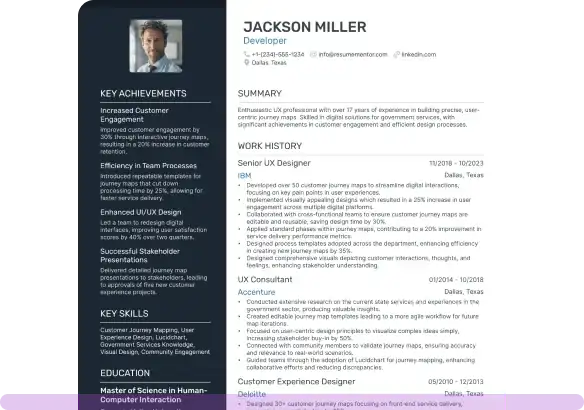English Teacher Resume Examples & Writing Tips for 2025

Jul 18, 2024
|
12 min read
Take a seat and let us teach you how to wow recruiters!
Rated by 348 people
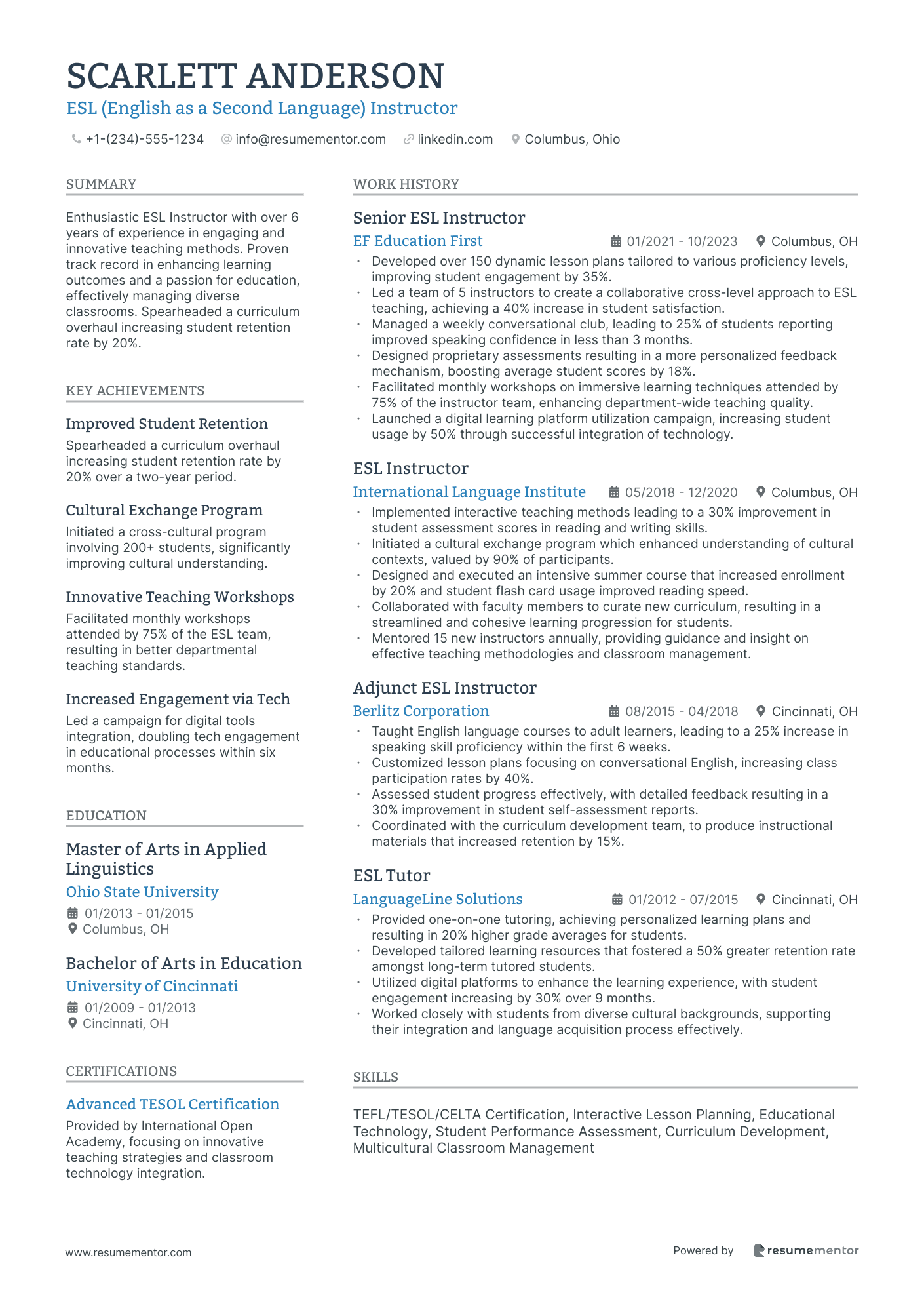
ESL (English as a Second Language) Instructor
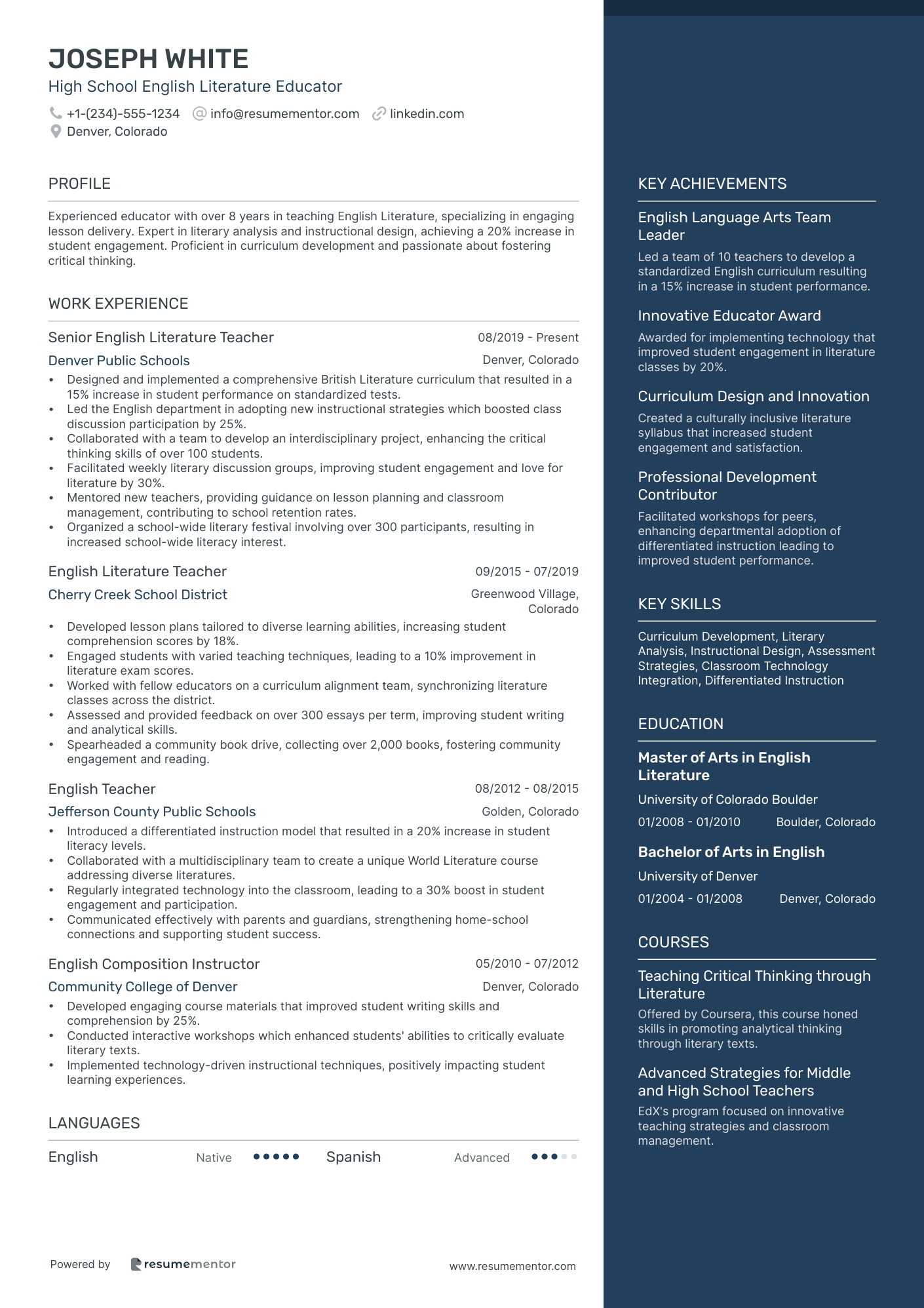
High School English Literature Educator
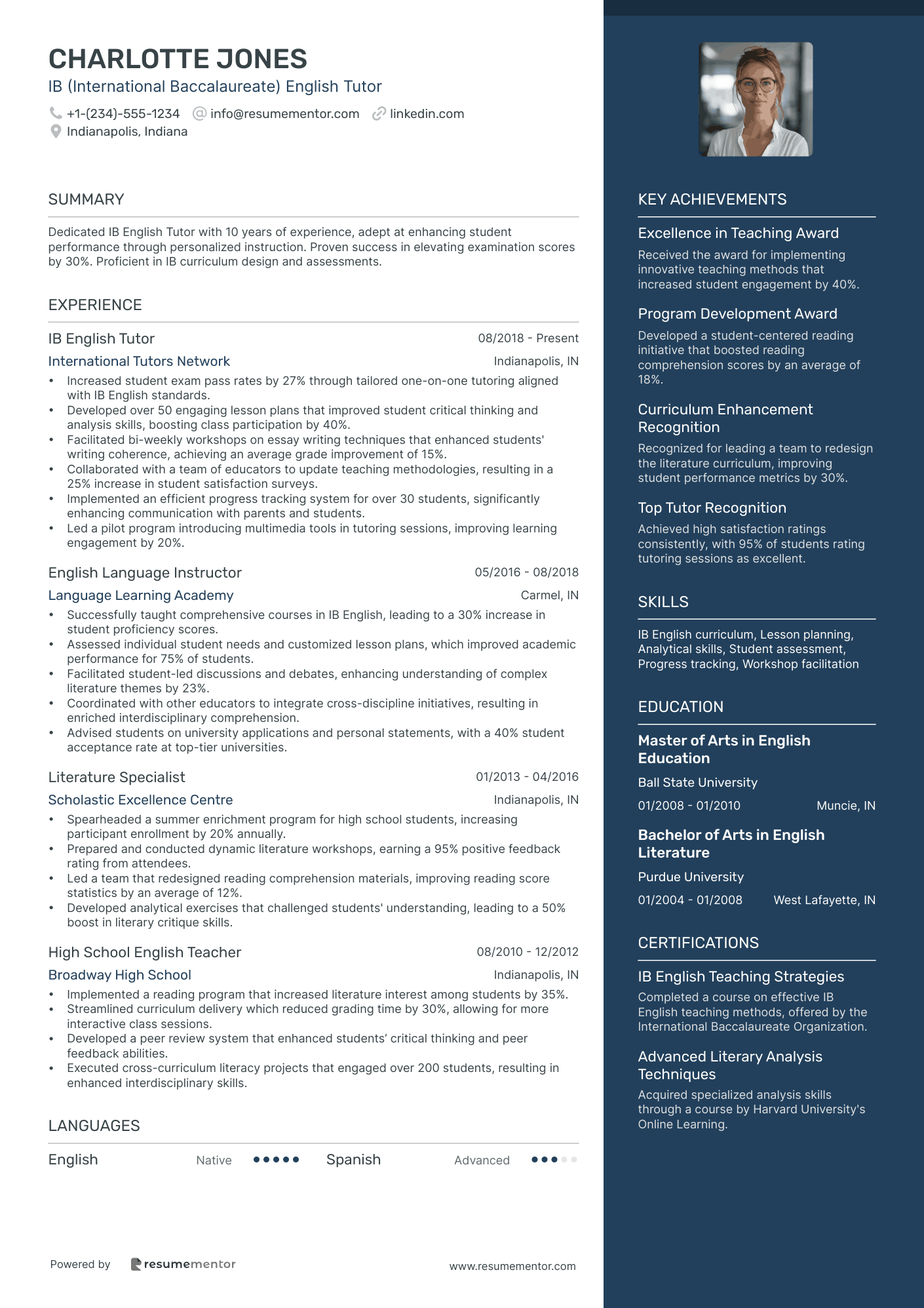
IB (International Baccalaureate) English Tutor
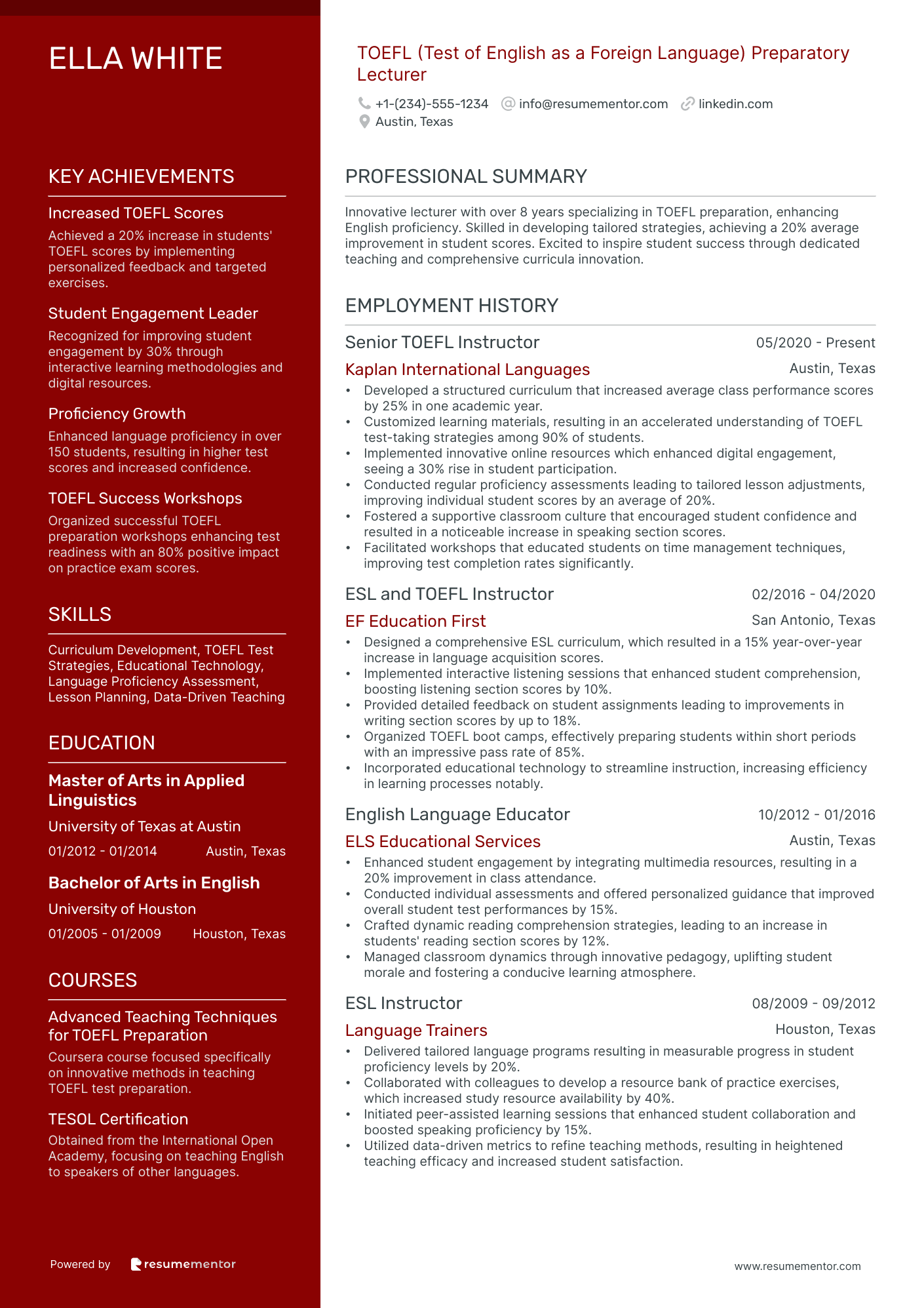
TOEFL (Test of English as a Foreign Language) Preparatory Lecturer
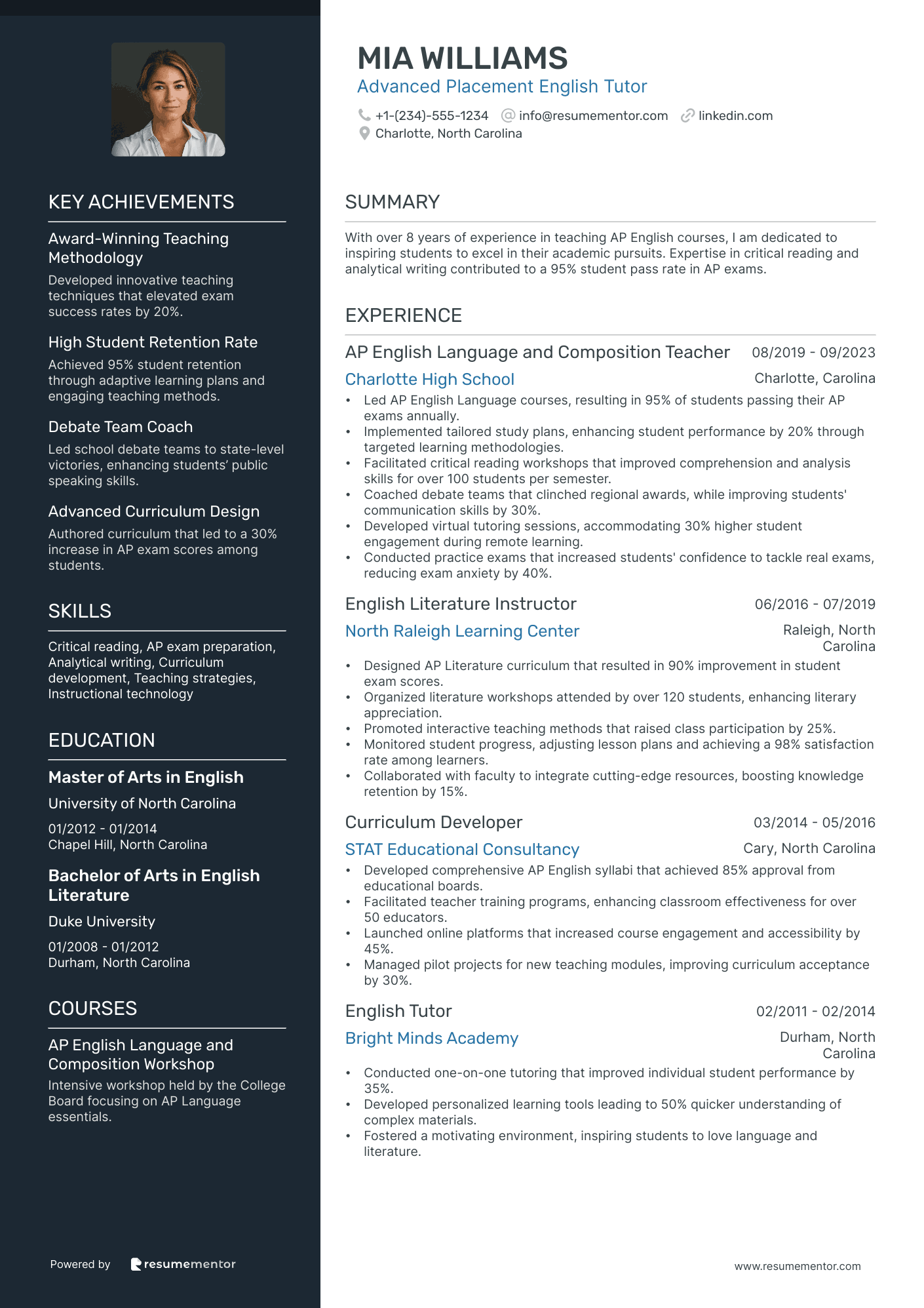
Advanced Placement English Tutor
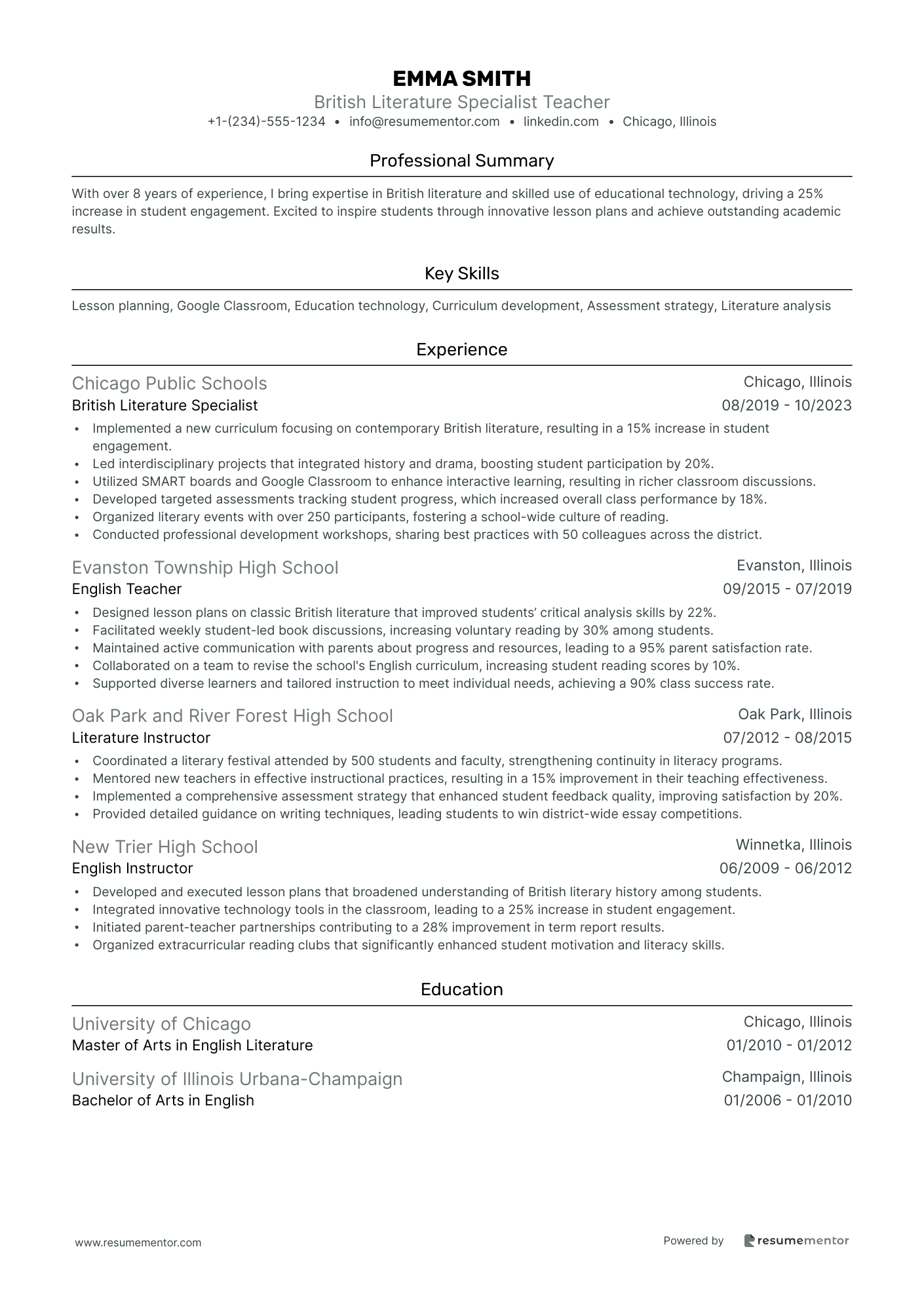
British Literature Specialist Teacher
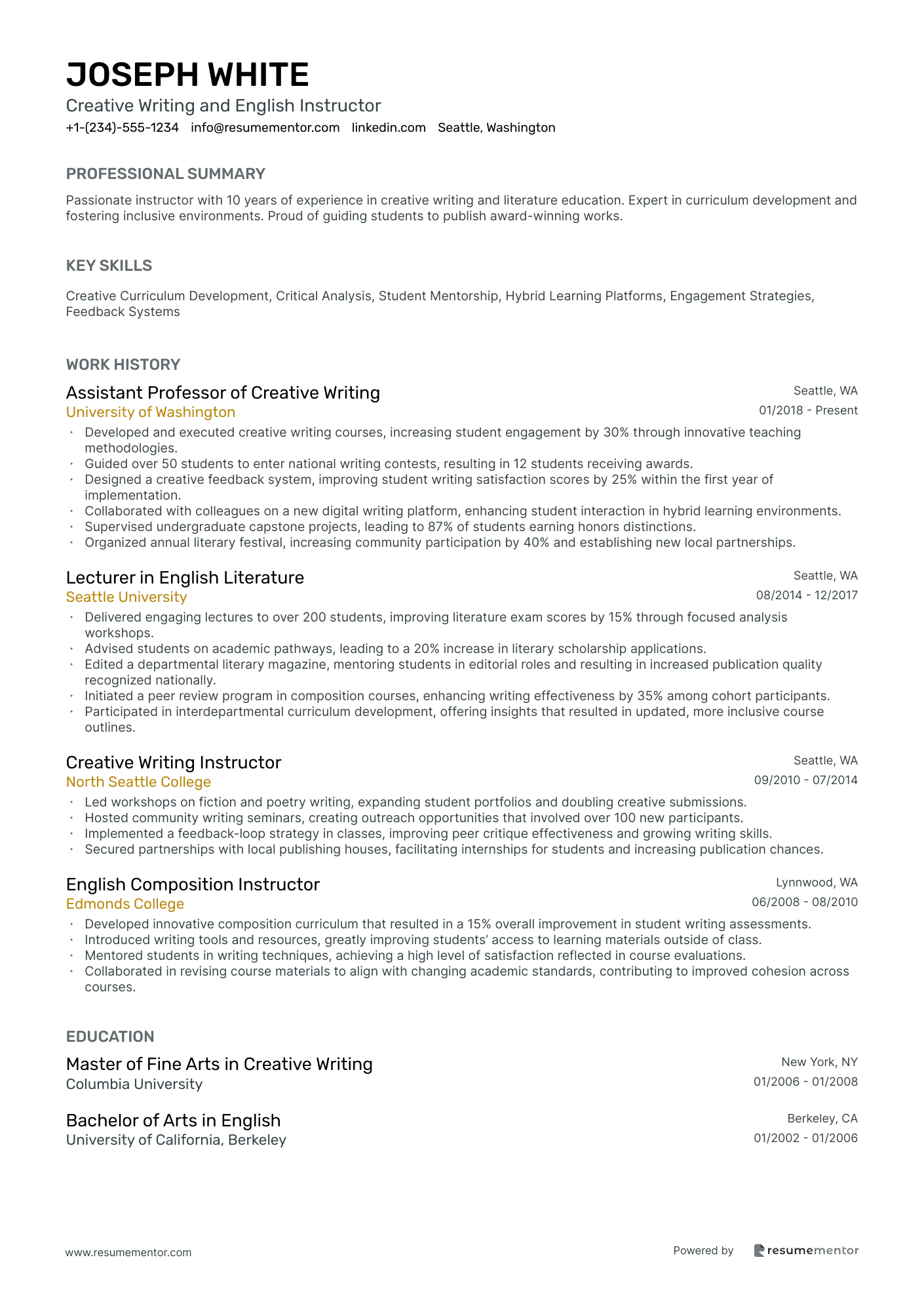
Creative Writing and English Instructor
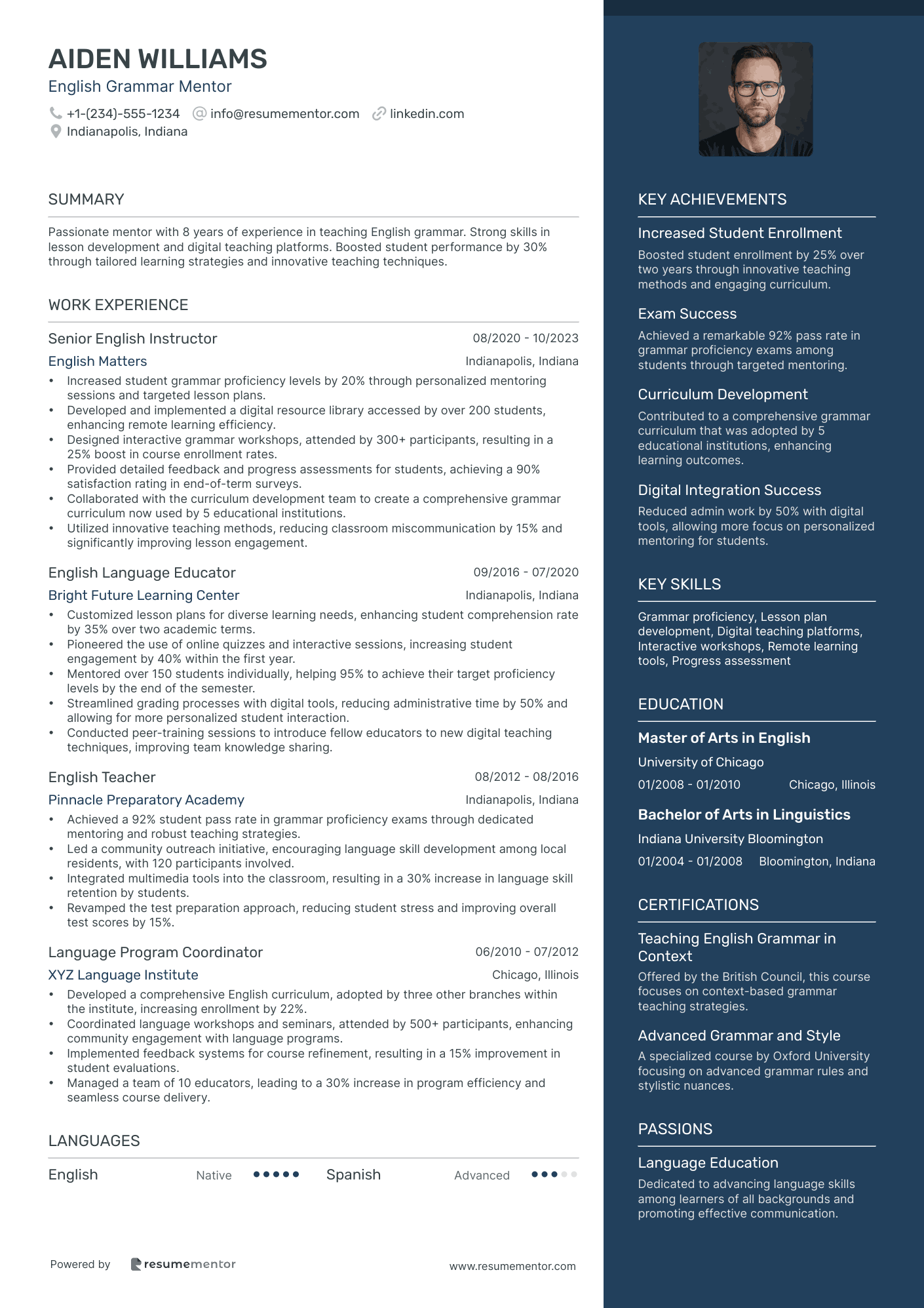
English Grammar Mentor
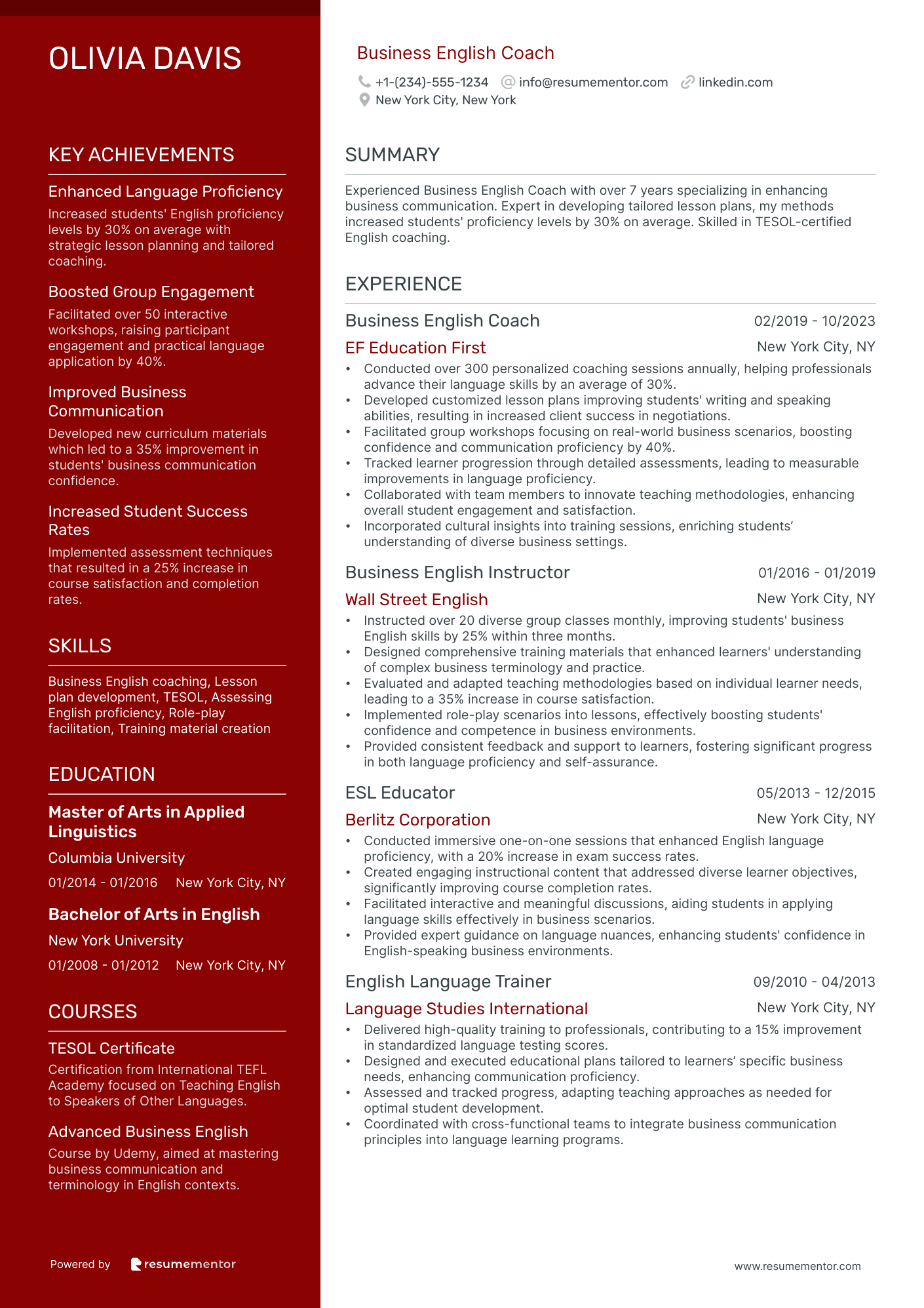
Business English Coach
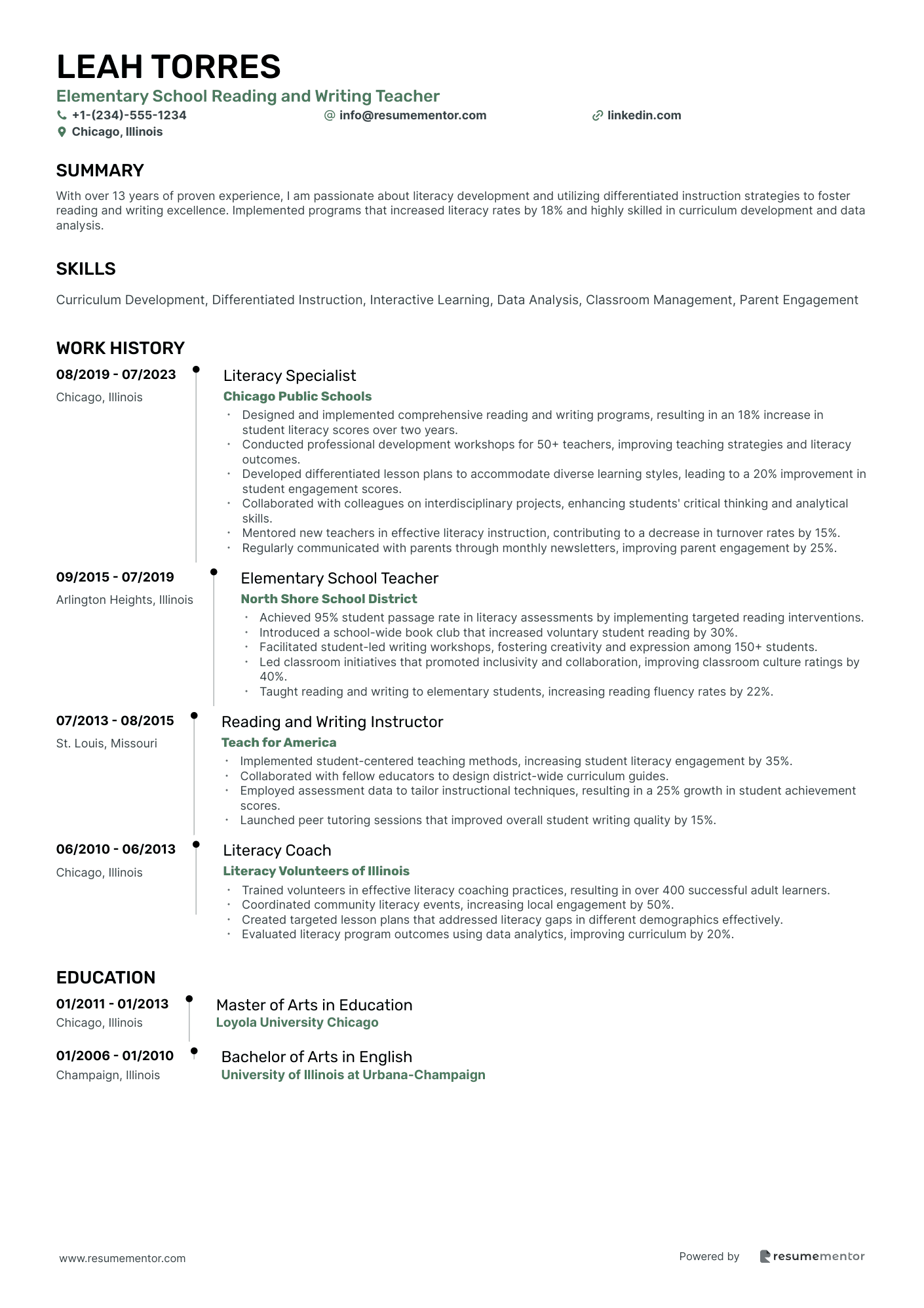
Elementary School Reading and Writing Teacher

ESL (English as a Second Language) Instructor resume sample
- •Developed over 150 dynamic lesson plans tailored to various proficiency levels, improving student engagement by 35%.
- •Led a team of 5 instructors to create a collaborative cross-level approach to ESL teaching, achieving a 40% increase in student satisfaction.
- •Managed a weekly conversational club, leading to 25% of students reporting improved speaking confidence in less than 3 months.
- •Designed proprietary assessments resulting in a more personalized feedback mechanism, boosting average student scores by 18%.
- •Facilitated monthly workshops on immersive learning techniques attended by 75% of the instructor team, enhancing department-wide teaching quality.
- •Launched a digital learning platform utilization campaign, increasing student usage by 50% through successful integration of technology.
- •Implemented interactive teaching methods leading to a 30% improvement in student assessment scores in reading and writing skills.
- •Initiated a cultural exchange program which enhanced understanding of cultural contexts, valued by 90% of participants.
- •Designed and executed an intensive summer course that increased enrollment by 20% and student flash card usage improved reading speed.
- •Collaborated with faculty members to curate new curriculum, resulting in a streamlined and cohesive learning progression for students.
- •Mentored 15 new instructors annually, providing guidance and insight on effective teaching methodologies and classroom management.
- •Taught English language courses to adult learners, leading to a 25% increase in speaking skill proficiency within the first 6 weeks.
- •Customized lesson plans focusing on conversational English, increasing class participation rates by 40%.
- •Assessed student progress effectively, with detailed feedback resulting in a 30% improvement in student self-assessment reports.
- •Coordinated with the curriculum development team, to produce instructional materials that increased retention by 15%.
- •Provided one-on-one tutoring, achieving personalized learning plans and resulting in 20% higher grade averages for students.
- •Developed tailored learning resources that fostered a 50% greater retention rate amongst long-term tutored students.
- •Utilized digital platforms to enhance the learning experience, with student engagement increasing by 30% over 9 months.
- •Worked closely with students from diverse cultural backgrounds, supporting their integration and language acquisition process effectively.
High School English Literature Educator resume sample
- •Designed and implemented a comprehensive British Literature curriculum that resulted in a 15% increase in student performance on standardized tests.
- •Led the English department in adopting new instructional strategies which boosted class discussion participation by 25%.
- •Collaborated with a team to develop an interdisciplinary project, enhancing the critical thinking skills of over 100 students.
- •Facilitated weekly literary discussion groups, improving student engagement and love for literature by 30%.
- •Mentored new teachers, providing guidance on lesson planning and classroom management, contributing to school retention rates.
- •Organized a school-wide literary festival involving over 300 participants, resulting in increased school-wide literacy interest.
- •Developed lesson plans tailored to diverse learning abilities, increasing student comprehension scores by 18%.
- •Engaged students with varied teaching techniques, leading to a 10% improvement in literature exam scores.
- •Worked with fellow educators on a curriculum alignment team, synchronizing literature classes across the district.
- •Assessed and provided feedback on over 300 essays per term, improving student writing and analytical skills.
- •Spearheaded a community book drive, collecting over 2,000 books, fostering community engagement and reading.
- •Introduced a differentiated instruction model that resulted in a 20% increase in student literacy levels.
- •Collaborated with a multidisciplinary team to create a unique World Literature course addressing diverse literatures.
- •Regularly integrated technology into the classroom, leading to a 30% boost in student engagement and participation.
- •Communicated effectively with parents and guardians, strengthening home-school connections and supporting student success.
- •Developed engaging course materials that improved student writing skills and comprehension by 25%.
- •Conducted interactive workshops which enhanced students' abilities to critically evaluate literary texts.
- •Implemented technology-driven instructional techniques, positively impacting student learning experiences.
IB (International Baccalaureate) English Tutor resume sample
- •Increased student exam pass rates by 27% through tailored one-on-one tutoring aligned with IB English standards.
- •Developed over 50 engaging lesson plans that improved student critical thinking and analysis skills, boosting class participation by 40%.
- •Facilitated bi-weekly workshops on essay writing techniques that enhanced students' writing coherence, achieving an average grade improvement of 15%.
- •Collaborated with a team of educators to update teaching methodologies, resulting in a 25% increase in student satisfaction surveys.
- •Implemented an efficient progress tracking system for over 30 students, significantly enhancing communication with parents and students.
- •Led a pilot program introducing multimedia tools in tutoring sessions, improving learning engagement by 20%.
- •Successfully taught comprehensive courses in IB English, leading to a 30% increase in student proficiency scores.
- •Assessed individual student needs and customized lesson plans, which improved academic performance for 75% of students.
- •Facilitated student-led discussions and debates, enhancing understanding of complex literature themes by 23%.
- •Coordinated with other educators to integrate cross-discipline initiatives, resulting in enriched interdisciplinary comprehension.
- •Advised students on university applications and personal statements, with a 40% student acceptance rate at top-tier universities.
- •Spearheaded a summer enrichment program for high school students, increasing participant enrollment by 20% annually.
- •Prepared and conducted dynamic literature workshops, earning a 95% positive feedback rating from attendees.
- •Led a team that redesigned reading comprehension materials, improving reading score statistics by an average of 12%.
- •Developed analytical exercises that challenged students' understanding, leading to a 50% boost in literary critique skills.
- •Implemented a reading program that increased literature interest among students by 35%.
- •Streamlined curriculum delivery which reduced grading time by 30%, allowing for more interactive class sessions.
- •Developed a peer review system that enhanced students’ critical thinking and peer feedback abilities.
- •Executed cross-curriculum literacy projects that engaged over 200 students, resulting in enhanced interdisciplinary skills.
TOEFL (Test of English as a Foreign Language) Preparatory Lecturer resume sample
- •Developed a structured curriculum that increased average class performance scores by 25% in one academic year.
- •Customized learning materials, resulting in an accelerated understanding of TOEFL test-taking strategies among 90% of students.
- •Implemented innovative online resources which enhanced digital engagement, seeing a 30% rise in student participation.
- •Conducted regular proficiency assessments leading to tailored lesson adjustments, improving individual student scores by an average of 20%.
- •Fostered a supportive classroom culture that encouraged student confidence and resulted in a noticeable increase in speaking section scores.
- •Facilitated workshops that educated students on time management techniques, improving test completion rates significantly.
- •Designed a comprehensive ESL curriculum, which resulted in a 15% year-over-year increase in language acquisition scores.
- •Implemented interactive listening sessions that enhanced student comprehension, boosting listening section scores by 10%.
- •Provided detailed feedback on student assignments leading to improvements in writing section scores by up to 18%.
- •Organized TOEFL boot camps, effectively preparing students within short periods with an impressive pass rate of 85%.
- •Incorporated educational technology to streamline instruction, increasing efficiency in learning processes notably.
- •Enhanced student engagement by integrating multimedia resources, resulting in a 20% improvement in class attendance.
- •Conducted individual assessments and offered personalized guidance that improved overall student test performances by 15%.
- •Crafted dynamic reading comprehension strategies, leading to an increase in students' reading section scores by 12%.
- •Managed classroom dynamics through innovative pedagogy, uplifting student morale and fostering a conducive learning atmosphere.
- •Delivered tailored language programs resulting in measurable progress in student proficiency levels by 20%.
- •Collaborated with colleagues to develop a resource bank of practice exercises, which increased study resource availability by 40%.
- •Initiated peer-assisted learning sessions that enhanced student collaboration and boosted speaking proficiency by 15%.
- •Utilized data-driven metrics to refine teaching methods, resulting in heightened teaching efficacy and increased student satisfaction.
Advanced Placement English Tutor resume sample
- •Led AP English Language courses, resulting in 95% of students passing their AP exams annually.
- •Implemented tailored study plans, enhancing student performance by 20% through targeted learning methodologies.
- •Facilitated critical reading workshops that improved comprehension and analysis skills for over 100 students per semester.
- •Coached debate teams that clinched regional awards, while improving students' communication skills by 30%.
- •Developed virtual tutoring sessions, accommodating 30% higher student engagement during remote learning.
- •Conducted practice exams that increased students' confidence to tackle real exams, reducing exam anxiety by 40%.
- •Designed AP Literature curriculum that resulted in 90% improvement in student exam scores.
- •Organized literature workshops attended by over 120 students, enhancing literary appreciation.
- •Promoted interactive teaching methods that raised class participation by 25%.
- •Monitored student progress, adjusting lesson plans and achieving a 98% satisfaction rate among learners.
- •Collaborated with faculty to integrate cutting-edge resources, boosting knowledge retention by 15%.
- •Developed comprehensive AP English syllabi that achieved 85% approval from educational boards.
- •Facilitated teacher training programs, enhancing classroom effectiveness for over 50 educators.
- •Launched online platforms that increased course engagement and accessibility by 45%.
- •Managed pilot projects for new teaching modules, improving curriculum acceptance by 30%.
- •Conducted one-on-one tutoring that improved individual student performance by 35%.
- •Developed personalized learning tools leading to 50% quicker understanding of complex materials.
- •Fostered a motivating environment, inspiring students to love language and literature.
British Literature Specialist Teacher resume sample
- •Implemented a new curriculum focusing on contemporary British literature, resulting in a 15% increase in student engagement.
- •Led interdisciplinary projects that integrated history and drama, boosting student participation by 20%.
- •Utilized SMART boards and Google Classroom to enhance interactive learning, resulting in richer classroom discussions.
- •Developed targeted assessments tracking student progress, which increased overall class performance by 18%.
- •Organized literary events with over 250 participants, fostering a school-wide culture of reading.
- •Conducted professional development workshops, sharing best practices with 50 colleagues across the district.
- •Designed lesson plans on classic British literature that improved students’ critical analysis skills by 22%.
- •Facilitated weekly student-led book discussions, increasing voluntary reading by 30% among students.
- •Maintained active communication with parents about progress and resources, leading to a 95% parent satisfaction rate.
- •Collaborated on a team to revise the school's English curriculum, increasing student reading scores by 10%.
- •Supported diverse learners and tailored instruction to meet individual needs, achieving a 90% class success rate.
- •Coordinated a literary festival attended by 500 students and faculty, strengthening continuity in literacy programs.
- •Mentored new teachers in effective instructional practices, resulting in a 15% improvement in their teaching effectiveness.
- •Implemented a comprehensive assessment strategy that enhanced student feedback quality, improving satisfaction by 20%.
- •Provided detailed guidance on writing techniques, leading students to win district-wide essay competitions.
- •Developed and executed lesson plans that broadened understanding of British literary history among students.
- •Integrated innovative technology tools in the classroom, leading to a 25% increase in student engagement.
- •Initiated parent-teacher partnerships contributing to a 28% improvement in term report results.
- •Organized extracurricular reading clubs that significantly enhanced student motivation and literacy skills.
Creative Writing and English Instructor resume sample
- •Developed and executed creative writing courses, increasing student engagement by 30% through innovative teaching methodologies.
- •Guided over 50 students to enter national writing contests, resulting in 12 students receiving awards.
- •Designed a creative feedback system, improving student writing satisfaction scores by 25% within the first year of implementation.
- •Collaborated with colleagues on a new digital writing platform, enhancing student interaction in hybrid learning environments.
- •Supervised undergraduate capstone projects, leading to 87% of students earning honors distinctions.
- •Organized annual literary festival, increasing community participation by 40% and establishing new local partnerships.
- •Delivered engaging lectures to over 200 students, improving literature exam scores by 15% through focused analysis workshops.
- •Advised students on academic pathways, leading to a 20% increase in literary scholarship applications.
- •Edited a departmental literary magazine, mentoring students in editorial roles and resulting in increased publication quality recognized nationally.
- •Initiated a peer review program in composition courses, enhancing writing effectiveness by 35% among cohort participants.
- •Participated in interdepartmental curriculum development, offering insights that resulted in updated, more inclusive course outlines.
- •Led workshops on fiction and poetry writing, expanding student portfolios and doubling creative submissions.
- •Hosted community writing seminars, creating outreach opportunities that involved over 100 new participants.
- •Implemented a feedback-loop strategy in classes, improving peer critique effectiveness and growing writing skills.
- •Secured partnerships with local publishing houses, facilitating internships for students and increasing publication chances.
- •Developed innovative composition curriculum that resulted in a 15% overall improvement in student writing assessments.
- •Introduced writing tools and resources, greatly improving students’ access to learning materials outside of class.
- •Mentored students in writing techniques, achieving a high level of satisfaction reflected in course evaluations.
- •Collaborated in revising course materials to align with changing academic standards, contributing to improved cohesion across courses.
English Grammar Mentor resume sample
- •Increased student grammar proficiency levels by 20% through personalized mentoring sessions and targeted lesson plans.
- •Developed and implemented a digital resource library accessed by over 200 students, enhancing remote learning efficiency.
- •Designed interactive grammar workshops, attended by 300+ participants, resulting in a 25% boost in course enrollment rates.
- •Provided detailed feedback and progress assessments for students, achieving a 90% satisfaction rating in end-of-term surveys.
- •Collaborated with the curriculum development team to create a comprehensive grammar curriculum now used by 5 educational institutions.
- •Utilized innovative teaching methods, reducing classroom miscommunication by 15% and significantly improving lesson engagement.
- •Customized lesson plans for diverse learning needs, enhancing student comprehension rate by 35% over two academic terms.
- •Pioneered the use of online quizzes and interactive sessions, increasing student engagement by 40% within the first year.
- •Mentored over 150 students individually, helping 95% to achieve their target proficiency levels by the end of the semester.
- •Streamlined grading processes with digital tools, reducing administrative time by 50% and allowing for more personalized student interaction.
- •Conducted peer-training sessions to introduce fellow educators to new digital teaching techniques, improving team knowledge sharing.
- •Achieved a 92% student pass rate in grammar proficiency exams through dedicated mentoring and robust teaching strategies.
- •Led a community outreach initiative, encouraging language skill development among local residents, with 120 participants involved.
- •Integrated multimedia tools into the classroom, resulting in a 30% increase in language skill retention by students.
- •Revamped the test preparation approach, reducing student stress and improving overall test scores by 15%.
- •Developed a comprehensive English curriculum, adopted by three other branches within the institute, increasing enrollment by 22%.
- •Coordinated language workshops and seminars, attended by 500+ participants, enhancing community engagement with language programs.
- •Implemented feedback systems for course refinement, resulting in a 15% improvement in student evaluations.
- •Managed a team of 10 educators, leading to a 30% increase in program efficiency and seamless course delivery.
Business English Coach resume sample
- •Conducted over 300 personalized coaching sessions annually, helping professionals advance their language skills by an average of 30%.
- •Developed customized lesson plans improving students' writing and speaking abilities, resulting in increased client success in negotiations.
- •Facilitated group workshops focusing on real-world business scenarios, boosting confidence and communication proficiency by 40%.
- •Tracked learner progression through detailed assessments, leading to measurable improvements in language proficiency.
- •Collaborated with team members to innovate teaching methodologies, enhancing overall student engagement and satisfaction.
- •Incorporated cultural insights into training sessions, enriching students’ understanding of diverse business settings.
- •Instructed over 20 diverse group classes monthly, improving students' business English skills by 25% within three months.
- •Designed comprehensive training materials that enhanced learners' understanding of complex business terminology and practice.
- •Evaluated and adapted teaching methodologies based on individual learner needs, leading to a 35% increase in course satisfaction.
- •Implemented role-play scenarios into lessons, effectively boosting students' confidence and competence in business environments.
- •Provided consistent feedback and support to learners, fostering significant progress in both language proficiency and self-assurance.
- •Conducted immersive one-on-one sessions that enhanced English language proficiency, with a 20% increase in exam success rates.
- •Created engaging instructional content that addressed diverse learner objectives, significantly improving course completion rates.
- •Facilitated interactive and meaningful discussions, aiding students in applying language skills effectively in business scenarios.
- •Provided expert guidance on language nuances, enhancing students' confidence in English-speaking business environments.
- •Delivered high-quality training to professionals, contributing to a 15% improvement in standardized language testing scores.
- •Designed and executed educational plans tailored to learners’ specific business needs, enhancing communication proficiency.
- •Assessed and tracked progress, adapting teaching approaches as needed for optimal student development.
- •Coordinated with cross-functional teams to integrate business communication principles into language learning programs.
Elementary School Reading and Writing Teacher resume sample
- •Designed and implemented comprehensive reading and writing programs, resulting in an 18% increase in student literacy scores over two years.
- •Conducted professional development workshops for 50+ teachers, improving teaching strategies and literacy outcomes.
- •Developed differentiated lesson plans to accommodate diverse learning styles, leading to a 20% improvement in student engagement scores.
- •Collaborated with colleagues on interdisciplinary projects, enhancing students' critical thinking and analytical skills.
- •Mentored new teachers in effective literacy instruction, contributing to a decrease in turnover rates by 15%.
- •Regularly communicated with parents through monthly newsletters, improving parent engagement by 25%.
- •Achieved 95% student passage rate in literacy assessments by implementing targeted reading interventions.
- •Introduced a school-wide book club that increased voluntary student reading by 30%.
- •Facilitated student-led writing workshops, fostering creativity and expression among 150+ students.
- •Led classroom initiatives that promoted inclusivity and collaboration, improving classroom culture ratings by 40%.
- •Taught reading and writing to elementary students, increasing reading fluency rates by 22%.
- •Implemented student-centered teaching methods, increasing student literacy engagement by 35%.
- •Collaborated with fellow educators to design district-wide curriculum guides.
- •Employed assessment data to tailor instructional techniques, resulting in a 25% growth in student achievement scores.
- •Launched peer tutoring sessions that improved overall student writing quality by 15%.
- •Trained volunteers in effective literacy coaching practices, resulting in over 400 successful adult learners.
- •Coordinated community literacy events, increasing local engagement by 50%.
- •Created targeted lesson plans that addressed literacy gaps in different demographics effectively.
- •Evaluated literacy program outcomes using data analytics, improving curriculum by 20%.
You’re a pro at deciphering Shakespeare's sonnets, understand iambic pentameter, and know the difference between a simile and a metaphor, but can you write an interview-winning resume? Chances are, you still have a thing or two to learn.
Impressing a recruiter with your teaching prowess takes research, precision, and skill. It’s about proving that you have the writing experience and the teaching know-how to inspire the next generation. But it doesn’t end there. In the age of EdTech, you’ll also want to highlight your digital literacy and name-check the tools and software you confidently use.
Your English teacher resume needs to tick all the boxes while also speaking the recruiter’s language. That means tailoring your resume for the school or academy, too.
If you’re ready to get started, you’ve come to the right place. In this guide, we’ll share all the advice you need plus tangible examples. Let class begin.
Key takeaways
- Customize your resume for each job by incorporating keywords from the job description and aligning your resume objective with the school’s needs.
- Use measurable achievements to demonstrate your impact.
- Choose a reverse-chronological format if you have teaching experience, listing your most recent roles and accomplishments first.
- Include any state teaching certificationsto prove your eligibility for public school positions.
- Highlight both hard and soft skills.
- Focus on your teaching experience by using bullet points to describe your accomplishments and provide quantifiable results.
- If you have limited experience, consider using a functional resume format that emphasizes your education, certifications, and transferable skills over work history.
- Mention any EdTech tools (Google Classroom, Kahoot, Canvas) you use to enhance learning and engage students.
- If applicable, include volunteer experience in schools, tutoring programs, or literacy initiatives to strengthen your resume.
How to use this English teacher resume guide
You wouldn’t deliver a lesson without a detailed plan. Writing a resume is no different. We’ve created an in-depth guide to help you write a persuasive English teacher resume. However, If you want to get the most out of it, you need some action points.
Let’s take a look at some tips you need to keep in mind:
Guide checklist
- Learn the basics first
Understanding the key sections and must-have skills for a standout English teacher resume that captures the attention of schools and hiring managers.
- Highlight your strengths
Show off your teaching expertise, curriculum development skills, and student engagement strategies.
- Start core sections
Add in sections like certifications, teaching experience, and educational background.
- Follow expert tips and advice
Check out our pro tips to get the expert-backed advice you need to succeed.
- Tailor your resume for the role
Emphasize classroom leadership, curriculum design, assessment strategies, and student success initiatives.
- Carry out independent research
Use trusted resources like EdJoin, Teach Away, and TESOL.org for industry-specific job search guidance.
- Showcase your professional certificates
List new certifications (TESOL, CELTA, state licensure), professional development, and technology integration skills (Google Classroom, Canvas, AI tools).
- Build with ease
Use our drag-and-drop resume builder to format your resume. It couldn't be easier!
Is your resume good enough?
Drop your resume here or choose a file.
PDF & DOCX only. Max 2MB file size.
What to focus on when writing your English teacher resume
Teaching is a competitive field. To nab that top job, you need to show you’re a cut above the rest. When writing your English teacher resume, consider what makes you unique.
While there are plenty of things you could cover, it always pays to be as specific as you can. We recommend focusing on any curriculum development experience, advanced degrees or qualifications, digital literacy, and written communication.
Let’s break each of those down:
Curriculum development experience
From lesson planning to instructional design, English teachers must do it all. Look for ways to highlight your curriculum development experience on your resume.
You might want to talk about how you approach adapting the curriculum for different learning needs or how you’ve used technology to kick things up a notch.
Curriculum development
Why not mention your curriculum development prowess in your skills section? List this as a core competency or hard skill.
Add some context to it by demonstrating it in your work experience section. Use bullet points to illustrate how you’ve developed and enhanced English curriculums in the past.
Advanced degrees or qualifications
Education matters when you work in this field. If you’re looking to win over the hiring manager, don’t be afraid to brag about your educational feats.
Mention your college degree when listing education on your resume. However, you also want to display any advanced degrees you have under your belt.
Advanced English teaching degrees
Let’s take a look at some advanced degrees an English teacher may have:
- Master of Education (M.Ed.) in English Education
- Master of Arts (M.A.) in English
- Master of Arts in Teaching (MAT) – English
- Ph.D. in English or English Education
- Postgraduate Certificate in Literacy Education
- Graduate Certificate in Digital Learning and Educational Technology
Digital literacy
Technology plays a core role in any classroom. EdTech—or the use of software, hardware, and digital resources—is central to any modern-day teaching role. If you want to win over the recruiter, it’s important that you weave digital literacy into the body of your resume.
PRO TIP
Be sure to understand the different types of EdTech available before you write about them.
Let’s take a look at the various categories:
- Online learning platforms (Google Classroom, Canvas, Moodle)
- AI-powered writing assistants (Grammarly, ChatGPT, QuillBot)
- Digital reading tools (CommonLit, Newsela, Epic!)
- Interactive storytelling apps (Storybird, Book Creator)
- Gamification tools (Kahoot, Quizlet, Gimkit)
- Video-based instruction (Edpuzzle, Flip, YouTube EDU)
Written communication
As an English teacher, your writing is going to be closely scrutinized. The recruiter will expect you to be a real wordsmith. For that reason, the phrases you use on your resume need to have an impact. Use clear, concise language to get your message across.
Avoid using business jargon or overly complicated sentence structures. Always look for ways to simplify your writing so that it’s as clear as possible. Let’s take a look at two examples below.
Bad example:
- Orchestrated the seamless facilitation of dynamic pedagogical methodologies to optimize learner engagement while leveraging cross-functional collaboration to drive literacy-centric initiatives aligned with institutional KPIs.
Good example:
- Developed and used engaging teaching methods to improve student learning and literacy skills while working with colleagues to enhance the curriculum.
Next up, let’s break down which format you should use.
How to choose the right resume format
Now that you understand what to include in your application, it’s time to consider the resume format.
There are three main options:
- Reverse-chronological order
- Functional format
- Combination format
If you’ve been teaching for years and have experience, choose the reverse-chronological format. The format details your career history, starting with your most recent accolades at the top of the page and working back in time.
If you’ve transitioned to teaching from another career, this structure may not work. In that situation, going for either the functional resume format or a combination is the answer. These options emphasize your skills over your experience.
What resume format should I use?
We recommend using the reverse-chronological resume format.
This is the structure that most hiring managers expect to see.
Should I include links on my resume?
You don’t have to. While some people give a hyperlink to their LinkedIn page, it isn’t necessary for English teaching jobs.
What’s the best file format for resumes?
It’s smart to save your resume as a PDF as these look professional and can’t be edited.
Can I include pictures on my resume?
You can but that doesn’t mean that you should. Pictures can detract from the content of your resume.
Which resume font should I choose?
Always opt for a font that's easy to read. Simple sans-serif fonts—like Arial and Rubik—are great options.
What’s the easiest way to make a resume?
Don’t mess around when making your resume. Our drag-and-drop resume builder is quick and easy to use. Simply add the sections you need and effortlessly create a beautiful resume.
Using the right format is just one part of the puzzle. Let’s move on to how to write a good header.
What to include in your resume header
At the top of the page, you’ll find the resume header. This section is a lot like a business card—it has your basic details and contact information. If you manage to wow the hiring manager with your resume, they’ll look at this section to contact you.
Let’s take a look at what you should include:
- Your name: Start with your first and last name.
- Job title: List the job title—i.e. “English Teacher.”
- Contact details: Next, add your phone number and email address.
- Location: Finally, give just your city and state (rather than your full address).
How to write a resume summary
Imagine you could look the hiring manager in the eye and tell them why you’re perfect for the job. What words would you use to persuade them that you’re the ideal candidate?
That’s the passion you want to bring to your resume summary. This short paragraph is often the first thing that a hiring manager reads. To grab their attention, include impressive accomplishments, stand-out talents, and other attributes that make you unique.
PRO TIP
Using resume action words is a must. These dynamic words make your resume summary more memorable than it would otherwise. Pepper them throughout the statement.
Looking for some inspiration? Why not focus on how long you’ve been teaching, the teaching approach you use, and your student grade stats? These features are bound to impress.
Always refer back to the job announcement before writing. Check out the core criteria and make sure you’re hitting the mark with the points you choose to include.
The above example talks about the teacher’s approach and the results they get. By including statistics in the mix, it provides evidence of the candidate’s track record.
How to write a quantifiable resume experience section
Now it’s time to put some work experience on your resume. This section is the meatiest of your resume—you have a fair bit of room to play with here. List out your relevant experience and use bullet points to detail your accomplishments in that position.
PRO TIP
If you want to know how far back to go on your resume, the simple answer is 10-15 years. Don’t go back any further than that as it can lead to age discrimination.
Get the formatting right. Start by including the name of the company, location, your job role, and the years you were employed. Below that, add your biggest achievements in the job.
Let’s take a look at an example:
- •Achieved a 98% pass rate on state standardized English exams for 12th-grade students.
- •Designed and led a school-wide writing program that increased student writing proficiency by 20%.
- •Mentored and guided a group of 25 ESL students, helping improve their English proficiency by an average of 30% over the academic year.
- •Utilized technology such as Google Classroom and Edpuzzle to enhance lesson engagement and track student progress.
- •Collaborated with fellow teachers to create interdisciplinary projects that encouraged critical thinking and creativity.
- •Increased students' reading comprehension scores by 15% by implementing differentiated reading strategies.
- •Created and managed a writing club that resulted in 10 students publishing their short stories in the school newsletter.
- •Designed curriculum for the integration of digital tools, increasing student engagement by 25%.
Test pass rates and improvements in student performance are front and center in this example. Including statistics and evidence in most points, is a surefire way to impress the reader.
English teacher resume work experience samples
How you position your English teacher resume depends largely on your professional strengths. Think about what makes you an impressive and valuable candidate.
To help you decide which angle to use, we’ve looked at three approaches:
Creativity focused
English teachers have the power to shape young minds. To do just that, many teachers use their innate creative flair. If you take a hands-on approach, include that in this section.
- •Developed an interdisciplinary unit blending literature, visual arts, and film, culminating in a student-created short film based on classic novels.
- •Launched a school-wide creative writing contest that resulted in the publication of an annual literary magazine featuring students' original poetry and stories.
- •Introduced 'Literary Art' projects where students created artwork inspired by novels and poetry, enhancing both creative and analytical skills.
- •Implemented interactive storytelling techniques, such as role-playing and digital storytelling, leading to increased student engagement and participation in class discussions.
- •Fostered a creative classroom environment that encouraged students to explore various genres of writing, including fantasy, science fiction, and experimental poetry.
- •Created and hosted monthly 'Open Mic' poetry and short story readings, allowing students to share their original work and build confidence.
- •Developed an interactive classroom where students collaborated on group writing projects, including a class-produced anthology of student work.
- •Organized an annual 'Poetry Slam' event where students performed their written pieces, boosting engagement in creative writing.
- •Introduced gamified writing challenges that inspired students to experiment with different writing styles and genres, resulting in 100% participation from students.
Results focused
Can you help any student pass the test? If you’re a pro at getting cold, hard results, that’s certain to help you stand out. Use tangible metrics in your work experience section.
- •Achieved a 97% pass rate for 12th-grade students on state English exams, consistently surpassing the school average by 10%.
- •Increased students' SAT Writing section scores by an average of 150 points over the course of one academic year through targeted writing instruction.
- •Developed and implemented a comprehensive writing curriculum, improving student essay quality and structure by 30% based on rubrics and peer evaluations.
- •Utilized data-driven strategies to identify students' weaknesses, resulting in a 25% increase in reading comprehension scores across all grade levels.
- •Coordinated after-school tutoring sessions, resulting in a 40% improvement in writing proficiency for struggling students.
- •Improved English language proficiency for ESL students by 40%, as measured by the WIDA (World-Class Instructional Design and Assessment) scores over one academic year.
- •Helped increase reading test scores for ESL students by 35%, using differentiated instruction and one-on-one tutoring.
- •Created a writing-intensive curriculum that resulted in a 25% improvement in writing assessments across the entire ESL program.
- •Increased engagement and participation in class discussions by 50% through active learning strategies and personalized feedback.
- •Collaborated with the special education department to design an inclusive curriculum, raising student reading comprehension levels by 30%.
EdTech focused
Have you fully embraced technology in the classroom? If the answer is yes, that could be your Unique Selling Proposition (USP). Include the tools you use by name and add context, explaining how they’ve supercharged your teaching approach.
- •Integrated Google Classroom, Edpuzzle, and Quizlet to create interactive lesson plans, boosting student participation by 35%.
- •Used Turnitin and Google Docs to provide real-time feedback on writing assignments, improving student revision rates by 40%.
- •Incorporated Kahoot and Socrative into review sessions, increasing student engagement and test preparation scores by 20%.
- •Developed an online writing portfolio system with Seesaw, enabling students to track their own progress and reflect on their writing development.
- •Led a school-wide professional development session on EdTech tools for literacy instruction, increasing teacher adoption of digital tools by 50%.
- •Introduced Padlet and Flipgrid for collaborative group projects, improving student collaboration and communication skills by 25%.
- •Implemented a flipped classroom model using Edmodo and YouTube, increasing student engagement by 30% and providing more personalized learning experiences.
- •Created digital assessments using Google Forms and Quizizz, streamlining grading and saving time while improving test accuracy by 15%.
- •Developed a student-led blog platform using WordPress, allowing students to publish their writing online and fostering a 20% increase in writing output.
- •Supported the adoption of Microsoft OneNote for note-taking, improving student organization and collaboration in group work by 40%.
How to write a resume if you have little to no experience
If you have no work experience in the education field, don’t panic. Everyone has to start somewhere. Focus on your education and any transferable skills you bring to the table.
Write a resume objective rather than a summary. This statement should include why you want to be a teacher, what has led you to this point, and what you hope to do in this career.
If you have volunteer experience in a school or educational setting, that’s a real bonus. Provide a volunteer section on your resume to draw attention to this experience.
Do English teachers need experience?
You can get an entry-level teaching job without experience. However, many schools prefer you to have student-teaching experience.
How can I gain teaching experience?
Most degree programs will include a student-teaching element. However, it doesn’t have to end there. You can also volunteer in a local school to gain additional experience.
How can I talk about my lack of experience?
Be honest about your lack of work experience on your resume. Focus on the passion you have for teaching, your qualifications, and the approach you intend to take.
Listing your skills on your resume
Ready to talk about what skills to put on a resume? Successful English teachers need a selection of hard and soft skills to captivate their students and get real results.
Your first port of call should be the job advert. Look at the core criteria and see what the recruiter expects. See how many of their boxes you can automatically tick there.
Use the same words as the job description when filling out your skills section. That’s a simple way to hook the recruiter and get past the Applicant Tracking System (ATS).
Here’s a good skills section example:
Best hard skills to feature on your English teacher resume
Hard skills—also known as technical skills—are at the core of your teaching practice.
Whether it’s using software or planning lessons, you need to have a good range of talents to get this job done. Make sure you’re specific when it comes to your resume.
Think about what the most in-demand resume competencies are for teaching.
Here are some examples:
- EdTech integration
- Differentiated instruction
- Curriculum design and development
- Language support tools (ESL/ELL)
- Remote teaching platforms
Check out an example skills section focusing on hard skills:
Best soft skills to feature on your English teacher resume
It’s not simply about your technical skills. You have to communicate clearly, engage students, and inspire them to work hard. That takes a load of soft skills.
These are often innate traits that help you do your job well. For example, you might be an ace at public speaking, have great interpersonal skills, or excel at time management. Whatever the case, throwing some of these into your skills section could make a huge difference.
Let’s see a good example:
Education on resume
If you’ve done all of the above, the next step is writing about your education on your resume. Use the reverse chronological order when creating this resume section.
English teachers are typically well-educated.
Let’s take a look at possible education:
Bachelor’s degree
Start with your college degree, especially if it’s in English or a related field. Note down your GPA as long as it’s above 3.5.
State certification
It’s a legal requirement to have state certification if you want to work in a US public school. Examples include the California Teaching Credential and New York State Teaching Certification. Check which you need according to the state you intend to work in.
Master’s degrees or PhDs
Of course, if you have any master’s degrees or even a PhD, add that to your education section. This additional education will elevate you above the competition.
Professional certificates
Finally, you may have some professional certifications, such as TESOL (Teaching English to Speakers of Other Languages) Certification or an ESL Endorsement. These are less important than your degrees, but still list them in this section.
Here’s an example of an education section:
- •Completed coursework in English literature, creative writing, and linguistics.
- •Participated in a semester-long teaching assistant program to assist in English composition courses.
- •Focused on advanced literacy techniques and reading instruction strategies.
- •Completed a thesis on the impact of technology on student engagement in high school English classrooms.
- •Completed TESOL certification program focused on teaching English to non-native speakers.
- •Gained hands-on experience with ESL students through a practicum in a local language center.
Extra sections to include in your English teacher resume
Do you have some extra space to use up? There are some additional sections you can include on your English teacher resume to help you grab some attention.
Language section
While English is your main subject, you may speak a second language. Add details of this in your language section. List your proficiency level for each new language.
Hobbies and interests section
When you’re not in the classroom, what do you like doing? Displaying some hobbies on your resume isn’t always necessary but it can help to strengthen your application.
Include interests that align well with teaching. For example, you should list any sports teams you play for, whether you’re writing a book, or if you host a reading group.
Volunteer work section
Many newbie English teachers get some volunteer work first. If you’ve been helping out at a local school, you can create a volunteer work resume section to share this.
- •Taught English grammar and conversation skills to adult learners in small group settings.
- •Developed lesson plans tailored to students' language proficiency levels.
- •Helped elementary school students develop reading fluency and comprehension skills.
- •Created engaging literacy activities to encourage a love for reading.
- •Organized and led weekly storytime sessions for children.
- •Assisted in curating educational materials for literacy programs.
Avoid walls of text!
To make your resume stand out, always make it skimmable. That means using bullet points, short sentences, and catchy phrases wherever you can.
Conclusion
Hooking a recruiter’s attention is the first step toward success. To help you land your next English teacher job, you’ll need a well-thought-out resume. Use our resume builder now—the drag-and-drop tool means it’s easier than ever to create a winning design.
Related Articles
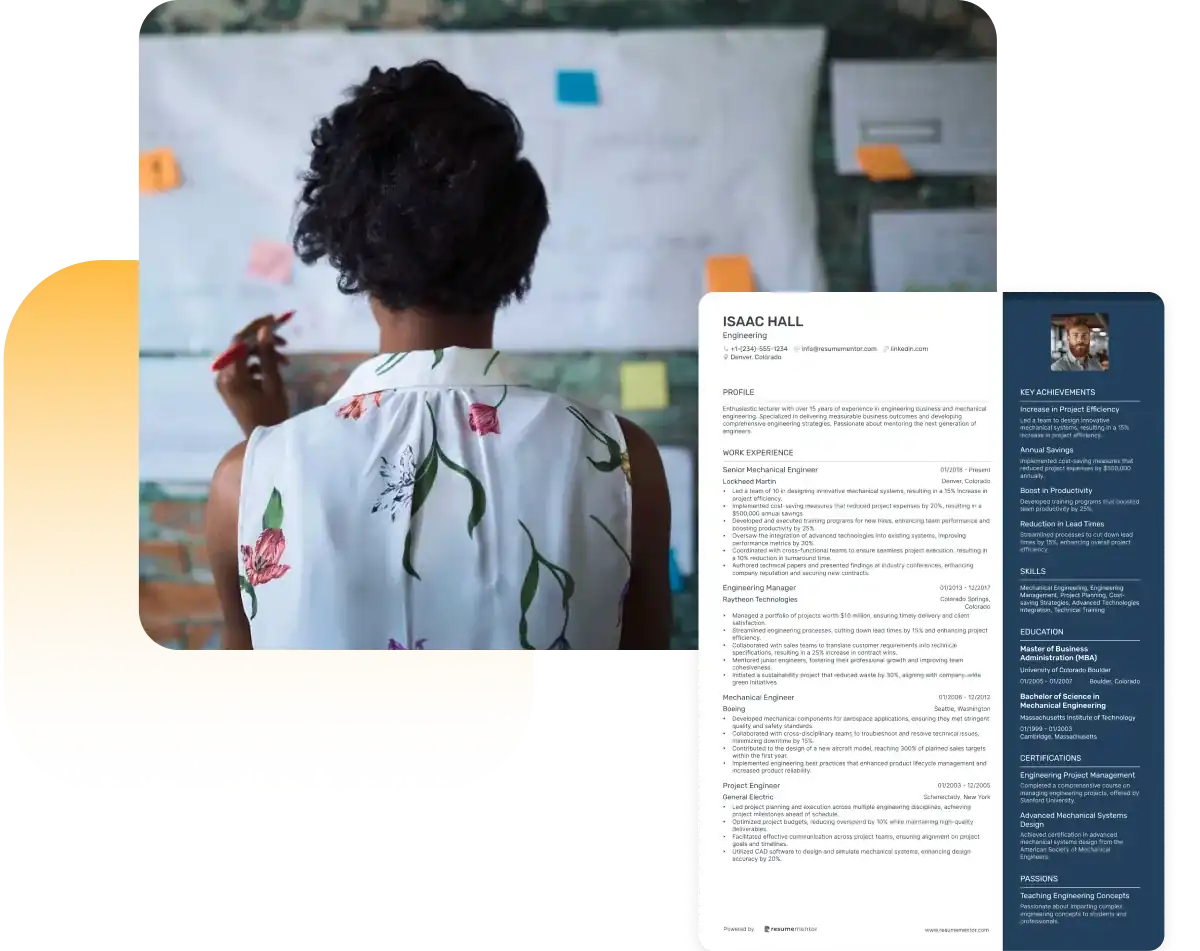
Continue Reading
Check more recommended readings to get the job of your dreams.
Resume
Resources
Tools
© 2025. All rights reserved.
Made with love by people who care.

